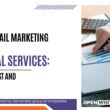The tech landscape is a battlefield. With new players constantly emerging and established giants vying for dominance, demand generation has become a critical weapon in the fight for market share. But for tech titans, traditional marketing tactics often fall flat. They need innovative strategies to cut through the noise and capture the attention of a sophisticated audience.
This article explores how tech titans are pushing the boundaries of demand generation, focusing on strategies that resonate with today’s tech-savvy customers.
1. Content Marketing as Thought Leadership:
Tech titans are moving beyond generic blog posts and white papers. They’re establishing themselves as thought leaders by creating in-depth content that tackles industry challenges, explores future trends, and showcases their expertise. This content can be in various forms, including:
- Interactive white papers and reports: Engaging readers with data visualizations, quizzes, and interactive elements.
- Industry podcasts and webinars: Featuring renowned experts discussing cutting-edge topics and offering valuable insights.
- Original research and case studies: Highlighting the company’s impact and providing real-world examples of their solutions in action.
2. Hyper-Personalization and Account-Based Marketing (ABM):
Tech giants understand the importance of personalization. They leverage data analytics to tailor their messaging to specific customer segments and accounts. This hyper-personalization can involve:
- Dynamic website content: Websites that adapt content and CTAs based on user behavior and interests.
- Targeted email marketing campaigns: Personalized emails addressing the specific needs and challenges of each prospect.
- Account-based marketing (ABM): Focusing resources on high-value accounts with dedicated marketing and sales efforts.
3. Building Communities and Fostering Engagement:
Tech titans recognize the power of community. They’re creating online communities where potential customers can connect, share knowledge, and engage with the brand. This fosters brand loyalty and generates organic demand. Examples include:
- Online forums and discussion boards: Dedicated spaces for users to discuss industry trends, troubleshoot issues, and learn from each other.
- Social media groups and events: Utilizing platforms like LinkedIn to create groups and host online events that cultivate meaningful connections.
- User-generated content (UGC) campaigns: Encouraging users to create content showcasing how they utilize the company’s products and services.
4. Leveraging Influencer Marketing Strategically:
Tech titans are partnering with relevant influencers to reach targeted audiences. However, they’re moving beyond celebrity endorsements. They’re focusing on micro-influencers and industry experts who hold credibility and trust within their communities. This allows for more authentic and impactful messaging.
5. Experimentation and Data-Driven Optimization:
The tech giants understand that success lies in continuous improvement. They’re constantly testing and refining their demand generation strategies based on data analytics. A/B testing allows them to optimize everything from website copy to social media campaigns for maximum impact.
Conclusion:
In the ever-evolving tech landscape, demand generation is no longer a one-size-fits-all approach. Tech titans are leading the charge by innovating and implementing cutting-edge strategies. From thought leadership content to hyper-personalization and community building, they’re ensuring their message resonates with the right audience, propelling them to continued success.


